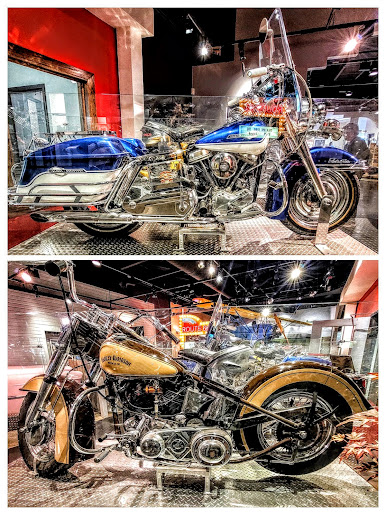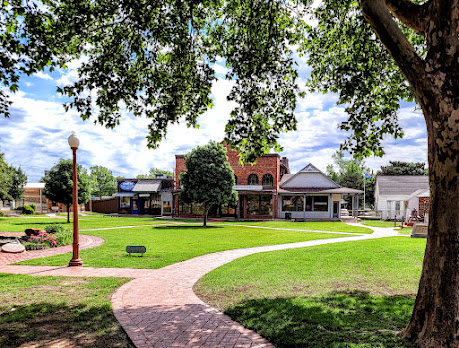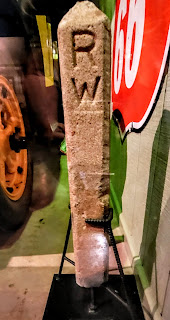It was time to depart Lubbock, for points beyond.
Of our four hour drive, three of it was tryin' to get out of Texas, but we finally made it. Carol climbed behind the wheel for awhile, then we switched back after a stop at the Oklahoma Visitor Center.Usually I tell you that nothing exciting happened during our drive, but it was a different story this trip. We were probably about 15 miles from our destination when this small car flew by us at what seemed 100 mph, trying to blow us off the road. A minute or so later two County Sheriff vehicles passed us by, then farther down the road another one passed us.
We have an action packed time during our short stay here. Go back to the paragraph above. While we were having lunch at the little restaurant/tavern...we struck up a conversation with the bar keep/waitress/hostess/check-in person (one person), and learned that it was in fact a high speed chase, but not the 100 mph I thought, it reached about 120 mph several times. Anyway, to make a short story longer, the suspect got off the highway, and on to surface streets. The last part of his run had him heading for a postal vehicle on her mail run, and... KAPOW... the police t-boned his car; it stopped him, and yes he survived the crash so that he could have his day in court.
The KOA we are staying at is right off the original Rte. 66, and part of our drive in Oklahoma was part of Rte. 66, just call it I-40 now.
We have an action packed time during our short stay here. Go back to the paragraph above. While we were having lunch at the little restaurant/tavern...we struck up a conversation with the bar keep/waitress/hostess/check-in person (one person), and learned that it was in fact a high speed chase, but not the 100 mph I thought, it reached about 120 mph several times. Anyway, to make a short story longer, the suspect got off the highway, and on to surface streets. The last part of his run had him heading for a postal vehicle on her mail run, and... KAPOW... the police t-boned his car; it stopped him, and yes he survived the crash so that he could have his day in court.
I took a walk and found myself done by Lake Clinton.I met some people while I was at the lake, and they told me some stories about how and why the water level is maintained. You see, if the water level gets too high at the west end, it floods across I-40. To remedy this they open the dam... When they open the flood gates, they flood the road below the dam...
Visitors climb into the pink caddy, step on the gas peddle and the screen in front starts rolling, the car looks like it is driving down the old Rte. 66.
...that would be this one.
The folks told me that I just missed the gates being opened by about two or three weeks.
The campground we are staying at is in between two Rte. 66 museums. The first one we stopped at was in Elk City. We have learned that each Rte. 66 museum is representative of the region it is in.
The Rte. 66 in Elk City was more of a history of the area before Rte. 66, and Rte. 66 era.
LOOK FAMILIAR
A LITTLE SMALLER THAN OURS
LONG TIME SINCE I WAS IN A CADILLAC
This Biscayne allows the visitor to watch movies at the drive in; there was a choice of four movies, three were "Creature From the Black Lagoon" and its sequels. The fourth movie was "The Blob".
The blue Harley Davidson is a 1965 Electra Glide. This 1965 bike was part of a special year for Harley Davidson, it was the last year they produced the "Panhead" engine. This engine received this loving name because the valve covers looked like cake pans. The other item that made this bike special was the "magic" electric starter; the only year that both items were installed on a bike.
The lower Harley Davidson is an EL Model, and was one of the first produced for civilians after WWII, the government had them tied up during the war. This is not a Spanish version, the EL has a meaning: "E" means it has a 60 cu inch motor, the "L" means it has high compression. If the first letter had been "F", it would have indicated that the bike had a 74 cu inch motor. 1946 was also the final year of the famous "Knucklehead" engine. Did you ever wonder why they called it a knucklehead? it was because the rocker boxes looked like a knuckle on a person's hand. The other item that is different from an original production in 1946, the 1949 front end hydraulic suspension. In 1946 the bike was manufactured with a "springer" front end suspension.
Exiting this part of the museum visitors make their way to the transportation portion of the museum.
Rte. 66 saw a lot in the early days, mass exodus from the Midwest during the dust bowl years, the stock market crash, and some of the worst roads a vehicle could travel. The later years saw better roads and lots of travelers.
FUN FACT: the Phillip 66 gas company's name was inspired from two employees traveling Rte. 66. The passenger in the vehicle asked the driver how fast he was driving, and the driver told him 66 mph. There you have it, traveling 66 mph on Rte. 66 generated the name Phillip 66.
Some of the buildings are reproduction, others are originals moved to this museum square.
1ST WOODEN HOME IN ELK CITY ca. 1901
CHAPEL WINDOW
These windows were part of an old Methodist church in Clinton. The folks that originally bought the old church were going to turn it into their home after moving it to Elk City... that didn't happen due to a few unforeseen power line issues; the peak of the steeple was 30 feet high. The couple ended up selling the building, but kept the six stained glass windows. They eventually gave them to various church organizations, one of those being the Elk City United Methodist Church. Eventually these were sold during a charity event and placed in this church for visitors to enjoy.
Another home that was moved to this historic square had a second floor dedicated the Beutler brothers of the rodeo world. These brothers built an empire in the rodeo world with quality stock horses and bulls.
My question was, what do you do with the bulls when they are done...they become useful as luggage and foot apparel.
Torture for the sake of beauty, what a way to go.
REPLICA OF THE ORIGINAL ELK CITY
TRAIN DEPOT ca. 1920
Here is a little story about the joy of train travel in the early 1900's. In 1911 an excursion train was dispatched from Hammon, OK, to Wichita Falls, TX, for a baseball game. The train had 18 to 20 cars. By the time the train arrived in Wichita Falls, it was overflowing with passengers, and most of them missed the game. They didn't waste time finding a bar to get drunk at. Time came to head back home, so the railroad ended up putting 50 drunks into a boxcar, that was a mistake. Drunks from Frederick got into a fight with drunks from Altus. When the train pulled into Burkburnett, the crew added another boxcar, and moved all the drunks from Frederick to it. When the train arrived at Frederick, the crew backed the Frederick boxcar onto a railroad spur, and left it there. The other drunks made it to Altus.
This is a replica of the early day opera houses, and this one appears to be used for a variety of venues.
Before we drive to Clinton to visit the next Rte. 66 museum, I'm going to share a little joke with you.
My wife was band from Weight Watchers meetings for life. She dropped a bag of M&Ms on the floor. She commented that it was the best Hungry Hippos game she ever watched.
..... WE ARE DRIVING..... WE ARE DRIVING.....
The Rte. 66 museum in Clinton is more in the line of the history of the highway.
Looking back on the entire route, I think I have been on almost all of it at some point in time. We started collection Rte. 66 pins last year because there are a lot of places to visit.
Time for the history lesson:
The highway was commissioned in November, 1926, becoming the first national highway across the midwestern portion of the country east to west. The agreed upon route was 2,448 miles, from Grant Park in Chicago, to Santa Monica Pier in California.
Some of you have been driving Rte. 66, and never realized it.
Look at the map above and see that the highway ran through eight states: Illinois, Missouri, Kansas, Oklahoma, Texas, New Mexico, Arizona, and California. Sadly, the highway was decommission in 1985 when the last town, Williams, AZ was officially bypassed in 1984, by the new interstates. If you caught it, I said interstates. It took five interstates to replace Rte. 66: that would be I-55 (N-S, Chicago, IL to Gulf Coast), I-44 (E-W, St. Louis, MO to Wichita Falls, TX), I-40 (E-W, North Carolina to California), I-15 (N-S, Montana to California), and I-10 (E-W, Jacksonville, FL to Santa Monica, CA). The only portions of these interstates considered Rte. 66 run through the aforementioned states.
Looking at all the road signs on the highways today can be very confusing, but they ain't nothin' compared to what motorists saw back in the early days. Here are samples of the early road signs:
Got them all figured out? I will give you a hint on one of them. OT Ozark Trail. These sign, like others, could have been posted just about anywhere along the road, and when I say that I mean tree, rock, or if lucky, a post.
Imagine seeing this marker as you are driving, any idea what it means? this was a "right of way" marker at intersections.If you think real hard, you will realize that Rte. 66 actually started long before 1926, one could say it started the day the first gas-powered vehicle was invented... back in 1839. By 1896, Henry Ford operated his first gas-powered vehicle. In 1899 the government jumps at the opportunity to have this new form of transportation. The War Department had only one stipulation to buying their three cars, and that was, it was required to be equipped with the ability to be towed by mules should the car choose not to run.
Gas stations, they didn't just pop out of the ground when highways were created. Before gas stations, travelers got their gas at places like liveries, repair shops, or general stores.
The consumer would fill a bucket with gas, then take the bucket and funnel the gas into their car. As highways grew, so did the concept of gas stations. The early gas stations started out as mom-and-pop stations from their homes, eventually growing to having service centers as well as the gas pumps. Unlike the car today, the tanks on the early cars had small tanks, which required stopping about every 70 miles for gas.Between 1920 and 1930 gas stations grew from about 15,000 to almost 124,000.
The consumer would fill a bucket with gas, then take the bucket and funnel the gas into their car. As highways grew, so did the concept of gas stations. The early gas stations started out as mom-and-pop stations from their homes, eventually growing to having service centers as well as the gas pumps. Unlike the car today, the tanks on the early cars had small tanks, which required stopping about every 70 miles for gas.Between 1920 and 1930 gas stations grew from about 15,000 to almost 124,000.
1931 to 1940 saw a lot of traffic on Rte. 66 due to the "Dust Bowl". I didn't see the full image of the dust bowl, and thought it was only Texas and Oklahoma, but in reality it also included portions of Kansas, Colorado, and New Mexico. Thousands were fleeing west for a new life.
Many of those fleeing could not afford a vehicle any better than second or third hand, hoping and praying they made it west.
Many of those fleeing could not afford a vehicle any better than second or third hand, hoping and praying they made it west.
With the advent of the newer cars, higher speeds on the paved roads, and bigger engines, deaths grew as well. Here in Oklahoma the annual deaths were only 100 in 1920; by 1930 the number grew to 400; by 1936 the number was 685.
With more people traveling, there was a growing need to feed and bed them for the night. After the WWII, there were more travelers than ever, cafés, restaurants, and motels were popping up all along Rte. 66.
Rte. 66 efficiency did not impress Dwight Eisenhower, soon to be president. Having traveled the German Autobahn during WWII, and knew we could do better. When he became president, the Federal-Aid Highway Act authorized construction of what we now know as the interstate. Construction began in 1956, and the final portion of the original plan was completed in 1991. It did not stop there; the network has extended to a total of 46,876 miles, as of 2006. Here was the beginning of the end for Rte.66.
Lets return to the romantic part.
By the 1950's cafés were not only for travelers, but locals enjoyed their services too. Lets pop into one of those eateries providing services to the masses.Hey, the upholstery looks similar to our dinette in the Retro. "Happy Days was a good example of the party place for America's youth. Besides being the "happenin' place", it had a lingo all its own. Let me site you a few examples:
- "Adam's Ale" - water
- "Scorch the Dog and Drag it Through the Garden" - hot dog with relish
- "Adam and Eve on a Raft" - two poached eggs on toast
- "Drown One, Hold the Hail" - Coke no ice
- "Flop Two" - two fried eggs over easy
- "Blond with Sand" - coffee with cream and sugar
A whole new era was about to hit us on the head... Peace and Love. The "hippies" were headed to wherever they could get together and celebrate their philosophy, and that meant communes in places like Colorado, or New Mexico. Some went as far as Los Angeles, San Francisco, or even Chicago.
A lot of these microbuses were seen on Rte.66 in the day.
Hippies were a traveling kind of people, and lived out of their vans while traveling to their destinations. Their sleeping arrangements may even include sleeping outside under the stars. Some hippies did not have transportation and hitchhiked, relying on others for a ride.
The middle-class families generally stayed in any one of the motor lodges (motels) popping up along the route. With more motels, eventually to be hotels, the average family could now visit attractions that might not have been possible before. A good example might be the Midwest family going to visit Disneyland and Knotts Berry Farm.
The highway may not exist, but memories still do. Because of those memories, many cities have begun an effort to re-vitalize the history of Rte. 66, and this museum is a prime example. Here in Oklahoma they offer a Rte. 66 book detailing all the stops throughout Oklahoma. When visitors get to a stop, they can get their book stamped for that location. Carol and I have several in our Oklahoma book, with the intention of coming back to finish the rest of the spots.Tell me people didn't get their kicks on Rte. 66.
I just told you that Rte. 66 is not dead. Even though the highway is no longer as of 1985, the first Historic Rte. 66 Association was formed in 1987. Congress passed the Route 66 Corridor Preservation Program, which is administered by the National Park Service.
History lesson is over. A great time was had by all.






































No comments:
Post a Comment